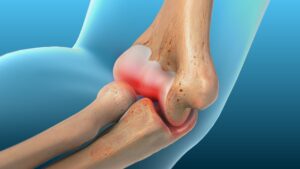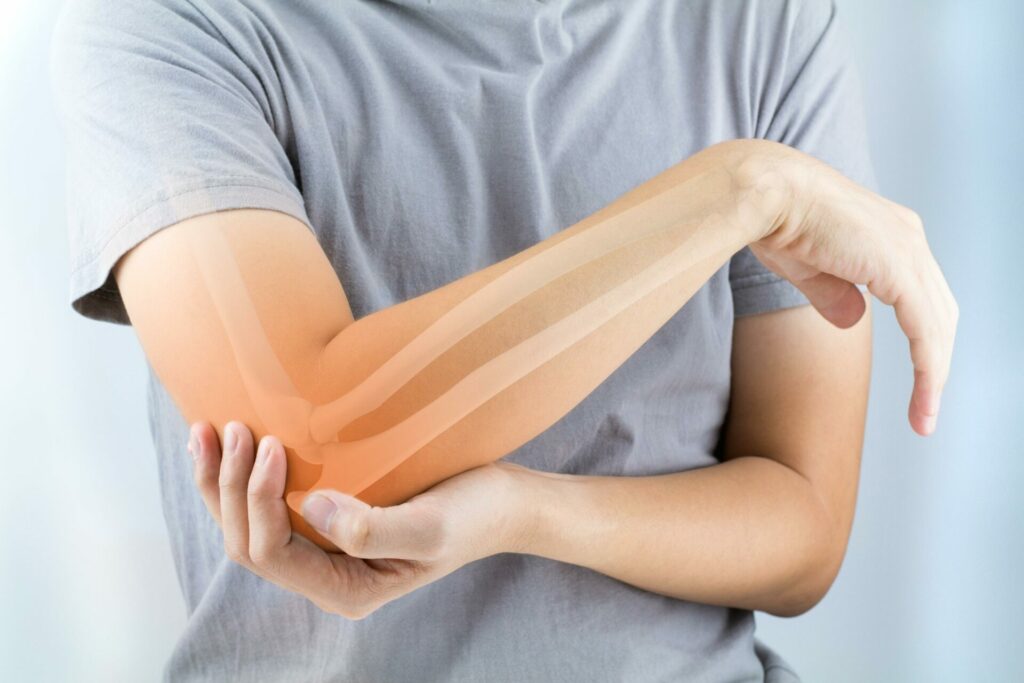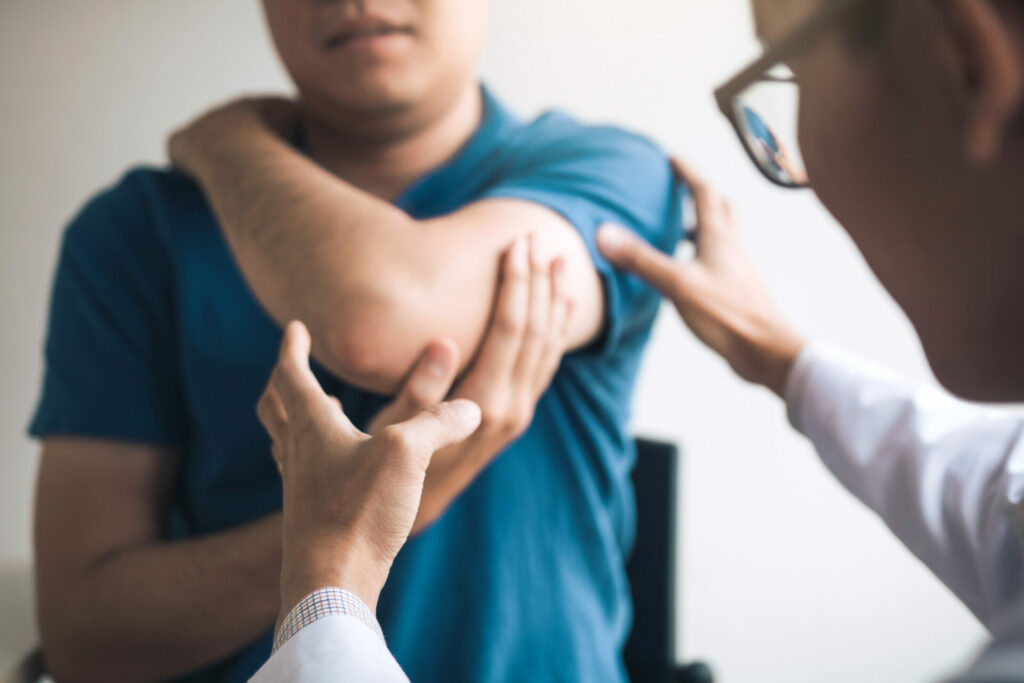There are many different types of pain that people experience, and elbow pain is one of them. This type of pain can be caused by a variety of factors, including injury, overuse, and arthritis. If you are experiencing elbow pain, it is important to seek medical attention to get the best treatment possible. In this blog post, we will discuss the causes, risk factors, and treatment options for elbow pain.
Contents
What Is Elbow Pain?

Elbow pain is any type of discomfort or soreness that affects the elbow joint. It can range from mild to severe, and it can be short-lived or chronic. There are many different causes of elbow pain, and it can be difficult to determine the exact cause without seeing a doctor.
There are three main types of elbow pain:
1. Joint pain: This type of pain is caused by inflammation or damage to the elbow joint itself. It can be caused by arthritis, injury, or overuse.
2. Nerve pain: This type of pain occurs when there is pressure on or damage to the nerves in the arm. It can be caused by conditions like carpal tunnel syndrome or ulnar nerve entrapment.
3. Muscle pain: This type of pain is caused by inflammation or damage to the muscles and tendons around the elbow joint. It can be caused by overuse, injury, or conditions like tennis elbow.
According to reports around 1% of the population experiences chronic elbow pain. It is more common in adults over the age of 40, and it affects men more often than women.
What Are The Symptoms of Elbow Pain?

The symptoms of elbow pain can vary depending on the underlying cause. Joint pain may cause the following symptoms:
Stiffness
One of the most common symptoms of elbow joint pain is stiffness. This may be due to inflammation or damage to the joint itself. The stiffness may make it difficult to move the arm, and it may be worse in the morning or after periods of rest. Sometimes there are also crackling or popping sounds when moving the elbow.
Swelling
Another common symptom of elbow joint pain is swelling. This may be due to inflammation or fluid buildup in the joint. The swelling can cause the elbow to feel stiff and difficult to move. It may also cause the skin around the elbow to appear red or warm to the touch. Swelling may be accompanied by itching and tenderness.
Muscle Pain
Muscle pain around the elbow is another common symptom of elbow pain. This type of pain is often caused by overuse or injury to the muscles and tendons around the elbow joint. It may feel like a dull ache, and it may be worse with activity. Also, the muscles may feel tight or tender to the touch.
Tenderness
Tenderness to touch is another symptom of elbow pain. This may be due to inflammation or damage to the elbow joint. The tenderness may make it painful to move the arm, and it may be worse with activity.
Deformity
In some cases, elbow joint pain can lead to deformity. This is usually the result of arthritis or injury. The deformity may cause the arm to look crooked or misshapen. In severe cases, it can make it difficult to fully extend the arm.
Numbness or Tingling
One of the most common symptoms of nerve pain is numbness or tingling. This may feel like pins and needles, and it may be worse at night. The numbness or tingling may extend to other parts of the arm, such as the hand. Sometimes the symptoms can be so severe that they interfere with sleep.
Weakness
Nerve pain conditions can also cause weakness in the arm. This may make it difficult to grip objects or perform certain activities. The weakness may extend to other parts of the arm, such as the hand.
Feeling of “Electric Shocks”
A feeling of “electric shocks” down the arm is another common symptom of nerve pain. This may be caused by damage to the nerves. The sensation may be worse at night or with activity. Sometimes the “shocks” can be so severe that they interfere with sleep.
Soreness In The Elbow
One of the most common symptoms of muscle pain is soreness in the elbow. This type of pain is often caused by overuse or injury to the muscles and tendons around the elbow joint. It may feel like a dull ache, and it may be worse with activity. Also, the muscles may feel tight or tender to the touch.
Pain That Gets Worse With Activity
An additional symptom of muscle pain is that it gets worse with activity. This may make it difficult to perform certain activities, such as gripping objects or extending the arm. The pain may also be worse at night or after periods of rest.
Stiffness In The Elbow
Another common symptom of muscle pain is stiffness in the elbow. This may make it difficult to move the arm, and it may be worse in the morning or after periods of rest. Sometimes there are also crackling or popping sounds when moving the elbow.
What Are the Causes of Elbow Pain?

Many different conditions can cause elbow pain. Some of the most common causes include:
Arthritis
Arthritis is a general term for conditions that cause inflammation and damage to the joints. The two most common types of arthritis that affect the elbow are osteoarthritis and rheumatoid arthritis. Osteoarthritis is a degenerative condition that occurs when the cartilage in the joints breaks down. Rheumatoid arthritis is an autoimmune condition that causes inflammation in the joints.
Injury
Elbow pain can be caused by injury to any of the structures in the elbow, such as the bones, muscles, tendons, or ligaments. Common injuries include fractures, dislocations, sprains, and strains. These injuries may be caused by trauma, such as a fall or car accident. They may also be caused by overuse, such as repetitive motions during work or sports.
Nerve Pain Conditions
Several nerve pain conditions can cause elbow pain. These include carpal tunnel syndrome, ulnar nerve entrapment, and radial tunnel syndrome. Carpal tunnel syndrome occurs when the median nerve becomes compressed at the wrist. Ulnar nerve entrapment occurs when the ulnar nerve becomes compressed at the elbow. Radial tunnel syndrome occurs when the radial nerve becomes compressed at the elbow.
Muscle Pain Conditions
Several muscle pain conditions can cause elbow pain. These include tennis elbow, golfer’s elbow, and biceps tendinitis. Tennis elbow is a condition that causes pain in the muscles and tendons around the elbow. Golfer’s elbow is a condition that causes pain in the muscles and tendons around the elbow. Biceps tendinitis is a condition that causes inflammation of the biceps tendon at the elbow.
What Are the Risk Factors for Elbow Pain?
Several risk factors can increase your chances of developing elbow pain. These include:
Age
The risk of developing elbow pain increases with age. This is due to the natural wear and tear on the joints, muscles, and connective tissues as we get older. When you are younger, these structures are more elastic and can better withstand stress.
Occupation
Certain occupations that require repetitive motions of the arm or elbow are at an increased risk of developing elbow pain. This includes jobs such as painting, carpentry, and plumbing.
Sports
Certain sports that involve repetitive motions of the arm or elbow are at an increased risk of developing elbow pain. This includes sports such as tennis, golf, and baseball.
Injury
Previous injury to the elbow increases the risk of developing elbow pain. This is because the structures in the elbow may be weakened and more susceptible to further injury.
Medical Conditions
Certain medical conditions can increase the risk of developing elbow pain. These include arthritis, diabetes, and obesity. Sometimes, these conditions can cause changes in the joints, muscles, and connective tissues that lead to pain.
How Is Elbow Pain Diagnosed?
Your doctor will ask you about your medical history and symptoms. They will then examine your elbow for signs of tenderness, swelling, or redness. They may also order imaging tests, such as X-rays or MRI, to further assess the structures in your elbow.
The diagnosis of elbow pain is typically based on a combination of your symptoms, medical history, and physical examination. Imaging tests may also be used to help confirm the diagnosis.
Another test for diagnosing elbow pain is an X-ray. This test can show whether there is any damage to the bones in the elbow. MRI is another imaging test that can be used to diagnose elbow pain. This test can show whether there is any damage to the soft tissues, such as the muscles, tendons, or ligaments.
What Are The Treatment Options for Elbow Pain?
There are many different treatment options for elbow pain. The best treatment plan for you will depend on the cause of your pain. Some common treatments include:
Rest
If your elbow pain is caused by overuse or injury, rest is often the best treatment. This means avoiding any activities that put stress on the elbow, such as sports or work. You may need to use a splint or brace to keep your elbow from moving.
Ice
Applying ice to the affected area can help reduce swelling and pain. Ice should be applied for 20 minutes at a time, several times a day.
Heat
Applying heat to the affected area can help reduce pain and stiffness. Heat should be applied for 20 minutes at a time, several times a day.
Exercise
If your elbow pain is caused by arthritis, exercise may help reduce pain and improve your range of motion. Exercise can also help maintain joint flexibility. It’s important to start slowly and gradually increase the intensity of your workouts.
Medications
There are many different types of medications that can be used to treat elbow pain. These include over-the-counter medications such as ibuprofen and aspirin, as well as prescription medications such as corticosteroids and opioids.
Surgery
In some cases, surgery may be necessary to treat elbow pain. This is usually only recommended if other treatments have failed. Surgery can involve procedures such as joint replacement, tendon repair, or nerve decompression.
Prevention of Elbow Pain

There are several things you can do to prevent elbow pain. These include:
Warm-up Before The Activity
It’s important to warm up before any activity that may put stress on the elbow. This helps increase blood flow to the muscles and tendons and reduces the risk of injury. Sometimes, a simple stretching routine is all that’s needed.
Use The Correct Technique
When participating in activities that may put stress on the elbow, it’s important to use the correct technique. This helps reduce the risk of overuse injuries. If you’re not sure how to properly execute an activity, seek out professional instruction.
Use The Proper Equipment
Using the proper equipment can help reduce the risk of elbow injuries. This is especially important in sports such as tennis and golf. Make sure you have the proper fitting equipment and that it is in good condition. Also, be sure to use the proper grip size for your hand.
Build Strength And Endurance
Keeping the muscles and tendons around the elbow strong can help prevent injuries. This can be done by participating in regular strength-training exercises. Endurance training is also important, as it helps reduce the risk of overuse injuries.
Maintain A Healthy Weight
Carrying extra body weight puts additional stress on the elbow joint. This can lead to pain and injury. Maintaining a healthy weight is one of the best things you can do to prevent elbow pain.
Stretch Regularly
Stretching the muscles and tendons around the elbow helps keep them flexible and decreases the risk of injury. Try to incorporate regular stretching into your daily routine.
If you experience elbow pain, it’s important to see a doctor to determine the cause. Once the cause is determined, treatment can begin. There are many different treatment options available, so there’s sure to be one that’s right for you. With proper treatment, most people can find relief from their pain and get back to their normal activities.
Conclusion
Elbow pain can be a nuisance, but fortunately, there are many treatment options available. If you’re experiencing elbow pain, talk to your doctor about the best course of action for you.
There are many different causes of elbow pain, so it’s important to consult with a medical professional to get an accurate diagnosis. Once the cause of your elbow pain has been identified, your doctor will develop a treatment plan that is tailored to your individual needs.
Treatment options for elbow pain vary depending on the underlying cause. In some cases, home remedies such as rest, ice, and over-the-counter pain relievers may be enough to relieve symptoms. In other cases, more aggressive treatments such as physical therapy or surgery.
Physical Therapy help patients recover from pain. If you’re experiencing Back pain, Shoulder pain, Knee pain, Neck pain, Elbow pain treatment, Hip pain, or Arthritis pain, a physical therapist at MantraCare can help: Book a physiotherapy session.


